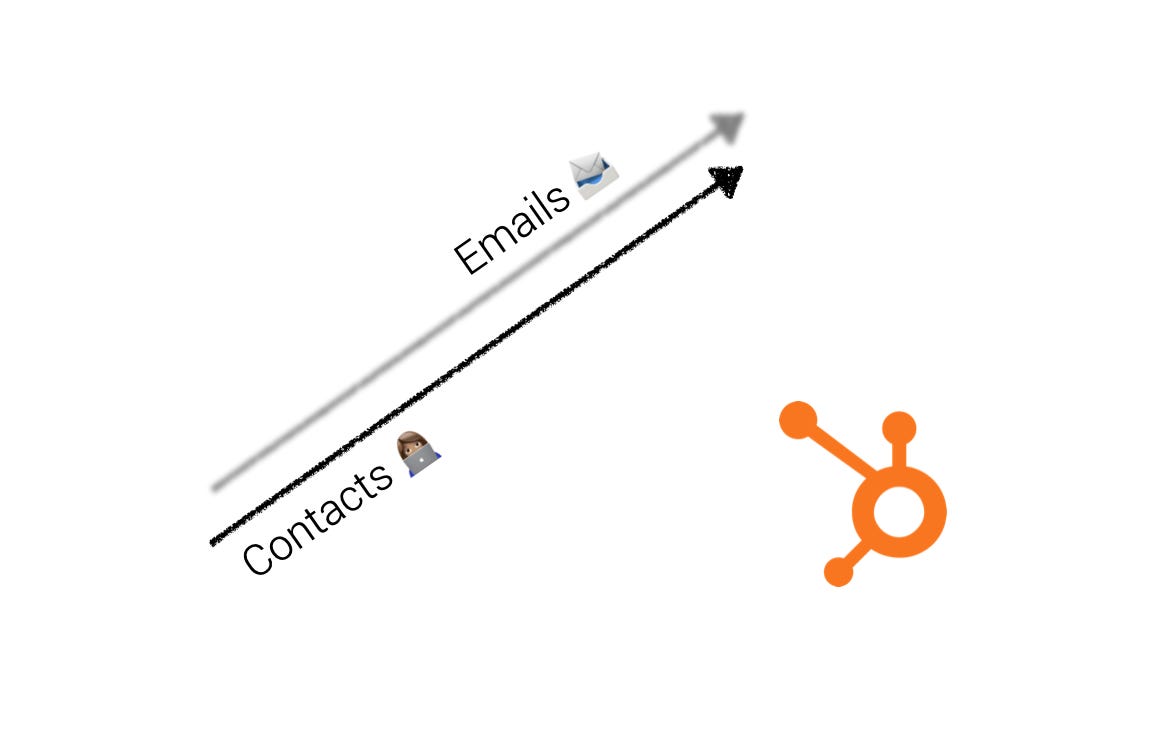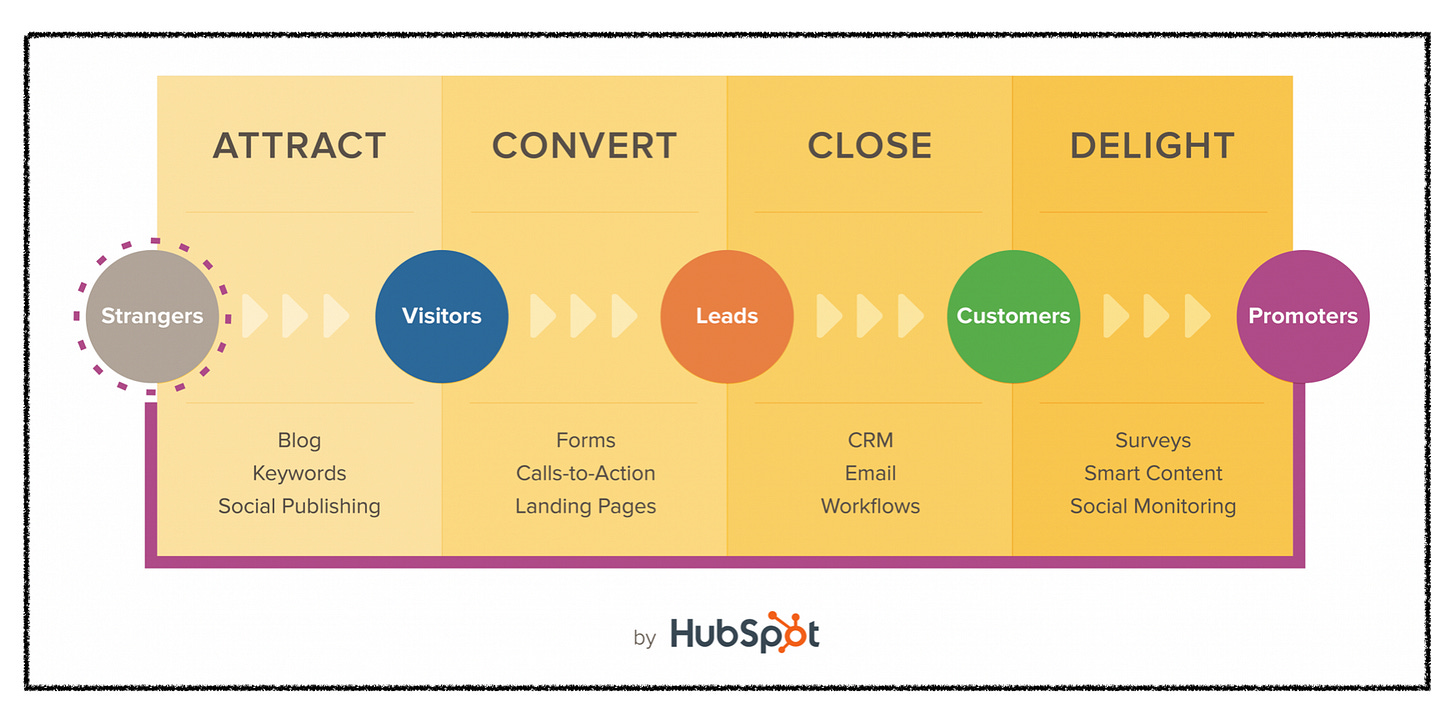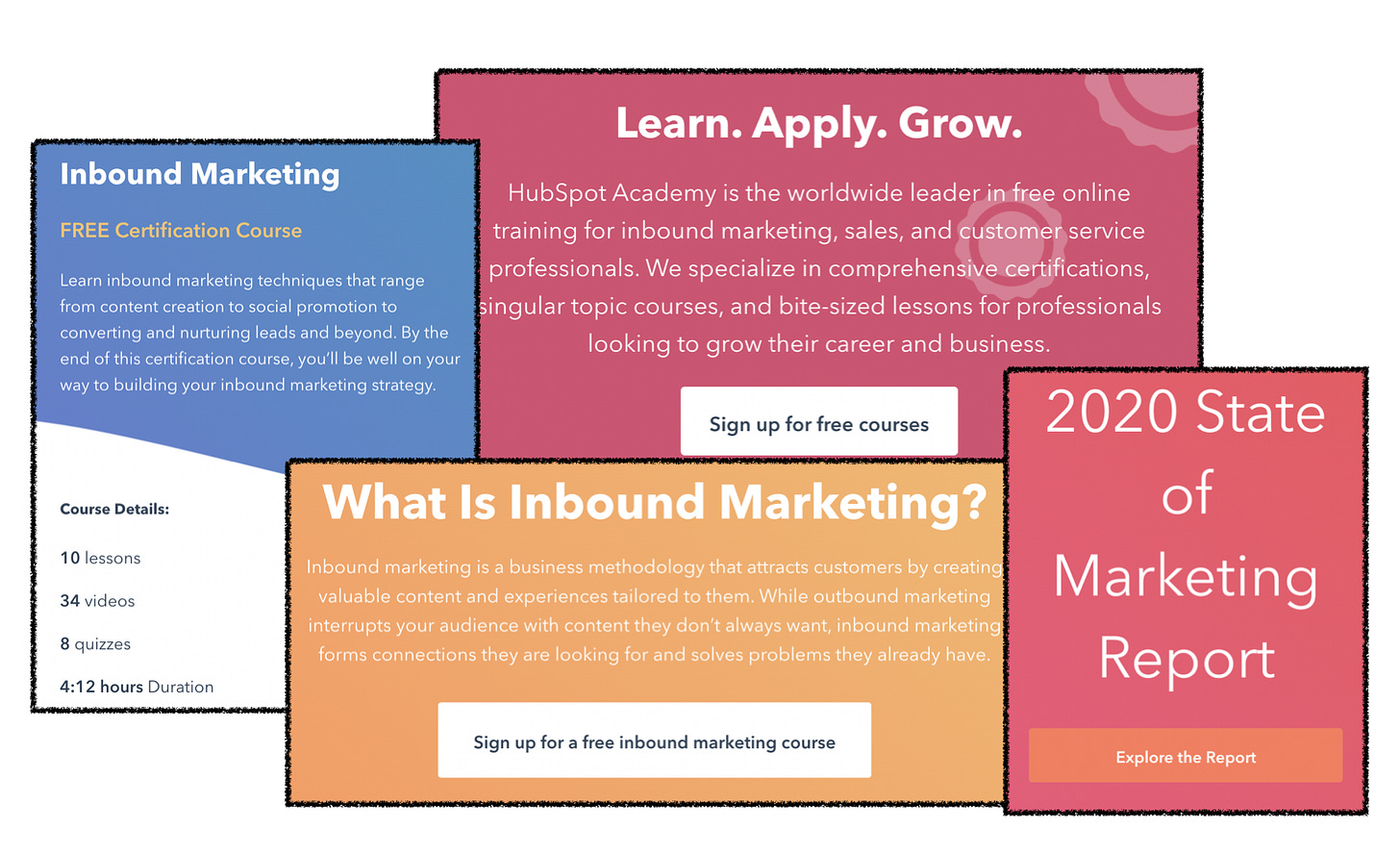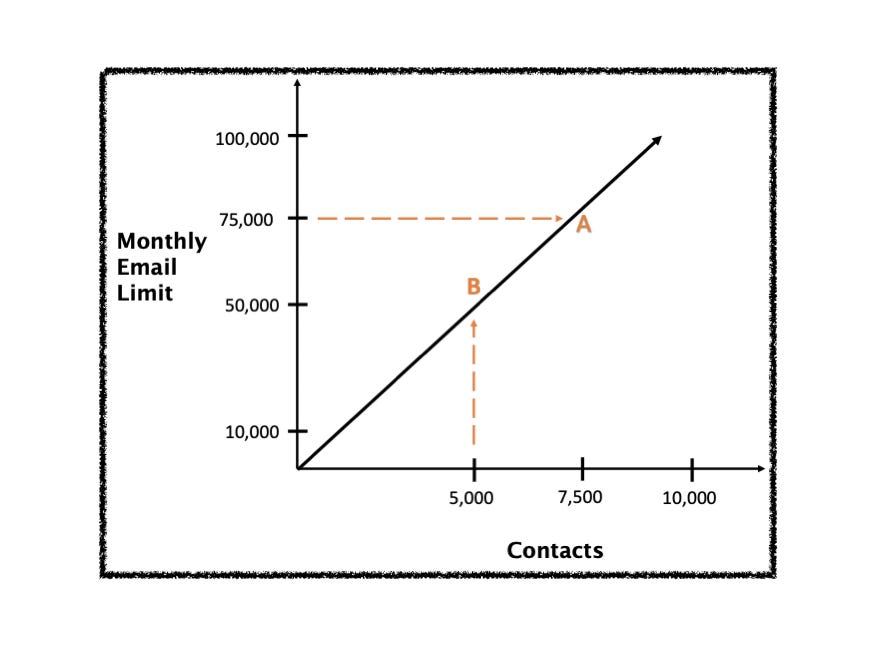SaaS Pricing is hard. PricingSaaS is your cheat code.
Monitor competitors, track real-time benchmarks, discover new strategies, and more.
Hey y’all,
It’s been a while since I’ve included a briefing before a post, but thought a high-level summary would serve as a nice primer before getting into the weeds!
I would love your feedback on this format. If you would enjoy having a quick briefing before each post so you know what you’re getting into, let me know by clicking the “like” button (the heart up at the top). That way I’ll know whether to make this a regular thing or to scrap it altogether.
On to this week’s analysis of a company near and dear to my heart, Hubspot.
Briefing 📋
Value Metric Fundamentals: A value metric is what and how you’re charging for your solution. For instance, Salesforce charges per user. At ProfitWell, we have 3 principles for a suitable value metric. It must:
Align with customer needs
Be easy to understand, and
Grow with the customer
Hubspot’s Primary Value Metric: Hubspot’s primary value metric, contacts, meets all 3 criteria. Contacts function as a proxy for growth, are an easy concept to understand, and should grow as the customer gets more value out of the Hubspot platform.
Hubspot’s Shadow Value Metric: While it’s not uncommon to have multiple value metrics, Hubspot’s unique because they tie a secondary value metric to contacts: monthly email sends. This approach not only gives Hubspot two axes for monetization and account expansion but also allows them to productize best practices and improve the Hubspot product.
There are many reasons Hubspot has maintained an astounding growth rate since going public in 2014. Their marketing engine is an acquisition machine, the product has only continued to get better, and their offices are filled with some of the smartest people I’ve ever worked with.
However, there’s a rare component to their pricing strategy that’s been key to their monetization and retention, their shadow value metric: monthly email sends.
I call it a shadow value metric because it’s closely tied to their primary value metric: contacts. The relationship between these two has major implications for the sales and customer success teams, and actively improves the Hubspot product.
Let’s dive in, starting with a quick introduction to value metrics.
Value Metric Fundamentals
Value metrics are at the heart of a value-based pricing strategy.
At ProfitWell, we define a value metric as what and how you’re charging for your solution. For instance, Salesforce charges per user.
When determining whether a value metric is suitable, we consider 3 key principles:
Does your value metric align with your customer’s needs?
Is it easy to understand?
Does your value metric grow with the customer?
Hubspot has always understood the power of value metrics. I spent almost 4 years there, and still consider their pricing strategy among the best I’ve seen.
Their primary value metric, contacts, passes all 3 key principles with flying colors.
Hubspot’s Primary Value Metric
Let’s quickly review each principle one-by-one, and set the foundation for why contacts works so well as a value metric.
Does your value metric align with your customer’s needs?
Hubspot’s goal is to help companies grow. Back in the day, they introduced the inbound marketing methodology to help customers visualize how the software would drive revenue growth by attracting visitors, converting those visitors into leads, nurturing those leads into customers, and delighting those customers to the point that they would promote their brand.
With this methodology in mind, generating more contacts is aligned with customer revenue goals and acts as a catalyst for the rest of the inbound methodology.
Is it easy to understand?
Contacts is an intuitive value metric to begin with, and once prospects grasped the methodology, they understood that contacts influence the subsequent stages of growth, eventually leading to more revenue. Further, many prospects would even start to conceptualize the subscriber growth they could achieve with Hubspot, and what that would mean for downstream customers and revenue.
Does your value metric grow with the customer?
As a customer grows contacts, the rest of the funnel should follow, resulting in more customers, promoters, and ultimately, more revenue. While contacts may not be a perfect proxy for revenue, the methodology helped codify the stages in between, making it easy for prospects to bridge the gap.
Now, if Hubspot charged on contacts alone, their pricing model would be solid, but they take it a step further. In the background, Hubspot has another value metric that’s tied to contacts: monthly email sends.
Hubspot’s Shadow Value Metric
A core part of the Hubspot marketing suite is email marketing and automation. The product has evolved well-beyond marketing software since I left, so I’ll utilize the past tense to refer to my personal experience.
While contacts functioned as the primary value metric, each customer had a monthly email send limit of 10x their total number of contacts. For example, if a customer had a list with 5,000 contacts, they could send up to 50,000 emails per month with Hubspot. If they exceeded 50,000, they would need to upgrade to the next contact level. This ratio impacted sales, customer success, and the Hubspot product.
Let’s start with sales. Hubspot’s shadow value metric helped the sales team establish expertise and gave us tons of leverage when pricing new customers.
The Hubspot sale was very consultative and educational. The sales team taught small to medium-sized businesses how to utilize inbound marketing and marketing automation to grow. This included the inbound marketing methodology referenced above along with SEO, conversion, and email best practices.
The Hubspot sales team was essentially an extension of the marketing team’s content engine that aimed to educate as many marketers as possible about inbound marketing. This education included courses, certifications, a prolific blog, research reports, and ultimately, sales conversations. When I was there, we called our first conversation with a prospect an Inbound Marketing Assessment, where we would analyze their marketing performance and diagnose opportunities to improve it.
The 1:10 ratio between contacts and monthly email sends is a benchmark we referenced as an upper-limit for effective audience nurturing. By productizing this best practice, we were able to quickly establish trust with prospects as we started the pricing conversation.
Plus, the ratio makes sense. If you’re a B2B company sending more than 10 emails to each subscriber every month, there’s a good chance you’re sending too many.
The benchmark resonated with prospects on both sides of the limit. Those that sent more than 10 emails per subscriber per month realized they should cut back, and companies that sent less than 10 emails per subscriber per month realized that they could be sending more.
Either way, prospects understood the logic and usually agreed, which kicked off the pricing conversation, something that can often be contentious, with a learning experience. From there, we would start talking pricing specifics.
First, we would work with prospects to understand their list size and average monthly email volume. Then we’d get insight into their growth rate to determine where they might be in a year.
Since we believed having to upgrade mid-year wouldn't be the best customer experience, we would usually anchor with a price that factored in anticipated growth. This gave us a range of possibilities between their current and future contact/email levels when determining what level to start with as a new customer. The answer to one of the most frequently asked questions on Hubspot’s pricing page, “Are there any overage fees?” provides a solid description of our pricing rationale.
If contacts was the only value metric, pricing a new prospect would have been relatively straightforward and objective. Adding the email limit to the mix made it more subjective, and gave the sales team leverage to determine what contact level was best for the customer. If a prospect pushed back on our initial quote, we could always discount down to a price between their current level and anticipated growth level.
Another stroke of pricing genius is that email volume was all upside. For example, let’s consider two prospects with 5,000 contacts:
Company A sends 75,000 emails per month (15 emails per month per contact)
Company B sends 10,000 emails per month (2 emails per month per contact)
With the 10x email limit, Company A would need to pay for the 7,500 contact level. Alternatively, even though Company B only sends 10,000 emails per month (the email limit for an account with 1,000 contacts) they would still need to pay for 5,000 contacts. As a result, Hubspot could always lock in the higher of the two.
Their shadow value metric also benefitted the Hubspot customer success team. Simply put, having two axes for monetization doubled the chances of account expansion.
Since contact growth acted as a proxy for revenue growth, breaking through the contact or email limit signaled to customers that the software was working. Customer Success Managers could then work with customers to understand their anticipated volume going forward and recommend a contact level to lock-in. Of course, this model allowed them to reach renewal targets as well.
Lastly, the shadow value metric benefitted the Hubspot product.
As we worked with prospects to understand the size of their list and monthly email volume, we would inevitably uncover insight into their list hygiene. Since the majority of customers would end up sending emails through Hubspot’s shared IPs, we encouraged them to only include actively engaged contacts that they had permission to email.
In fact, if customers had purchased email lists or had a large number of inactive subscribers, we would recommend that they either not import them, or launch a campaign from their existing email service provider directing them to a Hubspot landing page where they could convert them to their list of active subscribers.
This would ensure that Hubspot’s sender score remained high, reducing the chance that other customer’s emails landed in spam folders, and allowed us to tout a high deliverability rate.
The Power of Two
With contacts alone, Hubspot had a solid value metric.
With email sends tied to contacts, they created a multi-dimensional growth engine that empowered their sales and customer success teams and helped customers improve their marketing practices.
While other email service providers have adopted this approach, I’ve yet to see another dynamic like this where a pricing structure productized best practices (if you know of one, let me know!).
While a shadow value metric isn’t possible for every solution, it can be a tremendous source of leverage if you can make it work. At the very least, it’s worth thinking about the relationship between various usage metrics within your product to see if there’s an intuitive correlation hiding in plain sight.
Big thanks to Leigh (my lovely wife) for editing this post (and all posts), and providing design expertise for this week’s visuals!
Enjoying Good Better Best?
If you enjoyed this post, I’d love it if you hit the “like” button, that way I’ll know which posts are resonating the most!
If you have thoughts or feedback, I’d love to hear from you! You can find me on Twitter here.








